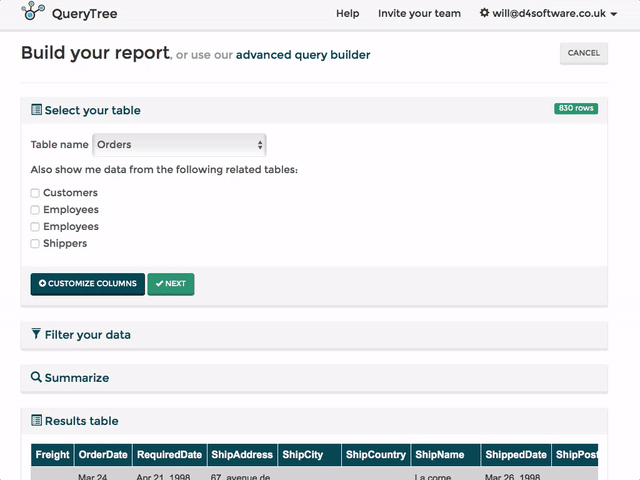Before QueryTree was open source it was a SaaS product. We hosted QueryTree on our servers and people paid us a monthly fee to use the product - which entailed connecting to their database and then running queries, building visualizations, and scheduling reports. All of this happened in a web browser.
Now QueryTree is open source there are many more potential use cases for it. With the code being available for anyone to use it also means there will be some use cases we haven’t thought of. But for now let’s look at some potential things we know you can do with QueryTree.
1. Integrate QueryTree into an existing app
This is the main reason we open-sourced QueryTree. There are countless companies out there with bespoke software. Many of these apps are complete solutions that enable entire businesses to run. Others are smaller apps that do specific jobs for people. These apps all have databases.
We’re talking along the lines of custom CRM systems, accounting software, HR management software, stock control systems, analytics etc. Any app where data is collected, held, and accessed in order to turn data into information.

QueryTree steps in to become a seamless part of the app, enabling people to access their databases, create visualizations, and schedule reports without leaving the current app space. This is great because it gives everyone self-serve access to their data, helping them answer their questions without technical assistance or knowledge.
Why not just build your own reporting and visualization software instead of using QueryTree? It takes a lot of effort and time to build a user-friendly and accurate reporting tool. QueryTree has already gone through numerous testing and iteration phases, meaning it’s ready to handle any database reporting as-is, out of the box.
2. Build your own analytics
There are a plethora of analytics tools out there. The thing is that most of them try to be something for everyone, leaving you trying to fit your needs around third party systems designed for everyone else’s needs.

Building your own in-house analytics can be an amazing thing if you’ve got the technical chops for it. Half of analytics is the reporting and visualizations that help you make sense of the data. There’s no reason to build your own reporting tool, not with access to QueryTree’s code which you can completely customize.
This has two bonuses: you’ve got a ready-to-go reporting and visualization aspect of analytics already built and you can customize it along with your analytics. You’ll save time on development (because you won’t need to build hefty reporting and viz software and do all the associated testing and iteration) without losing any of the control that comes with building your own analytics.
3. As a stand alone reporting and visualization tool
This was QueryTree’s original use. It serves the same purpose as an app integration, there’s just no QueryTree within the app. This would work by creating an instance of QueryTree that you hook up to your database(s). When you (or whomever) want to build a query or schedule a report you simply head to your QueryTree instance.

4. ???
Something we haven’t thought of or come across but that you’re thinking “hmm, I bet I could use QueryTree for this…”
Many more we’ve missed
These are just a few examples of how you can use QueryTree. It’s a dynamic tool that can be used in many scenarios so don’t feel limited by what we’ve laid out here - if you think there’s a potential use-case for QueryTree then go for it! If you get stuck or need some support, we’re always happy to help.
You can find the QueryTree codebase on GitHub.